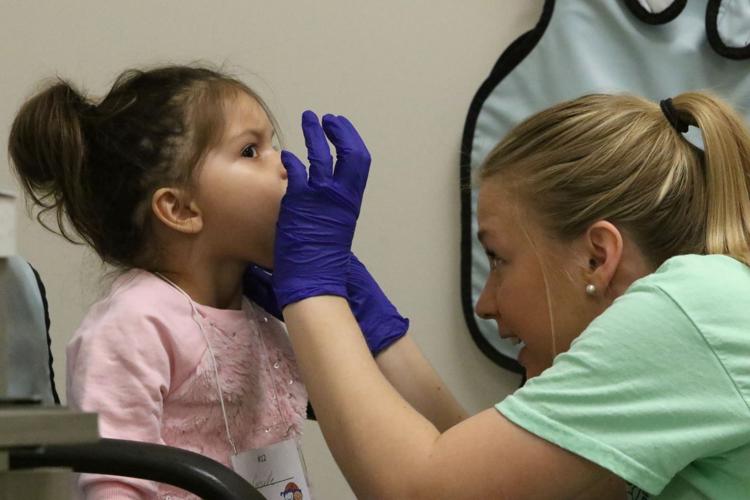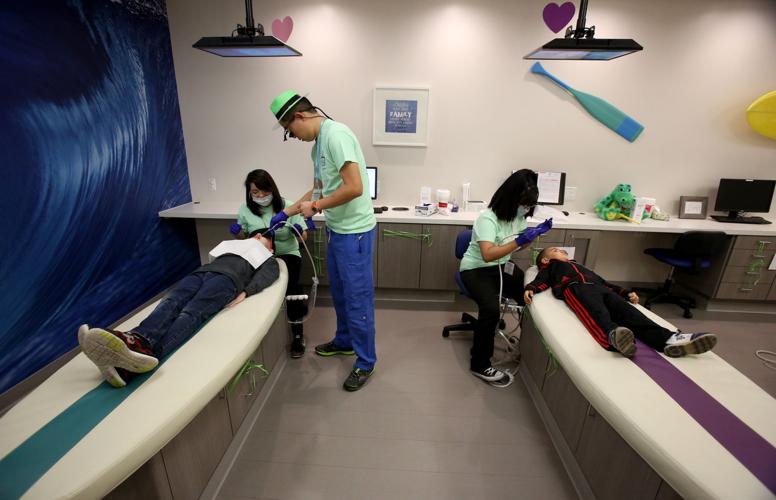Citing Arizona’s dismal rates of dental problems in children and adults, advocates are pushing for a type of provider called a dental therapist to be allowed here.
Dental therapists are “mid-level providers,” similar to the role that physician assistants and nurse practitioners play in the medical world. They are allowed in Minnesota, Maine and Vermont, on tribal land in Washington, Oregon and Alaska, and in some other countries including Australia and New Zealand.
An attempt to add dental therapists as licensed professionals in Arizona failed to pass muster with a legislative subcommittee in December, but advocates say they will try again. Paperwork required for the Arizona Legislature to consider legalizing dental therapists as providers is due Sept. 1.
“The momentum behind dental therapy is so strong, not just in Arizona, that it’s no longer a question of whether dental therapists will be licensed here or in other states,” said Kristen Mizzi Angelone, a dental policy officer with the Pew Charitable Trusts, which is working with proponents in the Dental Care for AZ coalition. “It’s really just a matter of when.”
Proponents of dental therapists in Arizona, which include the conservative leaning Goldwater Institute, the Arizona Dental Hygienists Association and the Inter-Tribal Council of Arizona, argue that they could provide a limited scope of dental procedures such as fillings, extractions and crowns at a lower cost.
But they’ve run into an obstacle in organized dentistry, which says adding a new category of health provider is the wrong strategy. The American Dental Association says there is a critical need to connect underserved people seeking care with dentists. The group says that can be achieved through increased awareness, outreach and improved funding for dental services under Medicaid.
There are other ways, the dentists say, to improve oral health in Arizona, such as adding more teledentistry, removing administrative barriers within the managed care system for Medicaid, and attracting more dentists to rural areas.
As for the dental therapists push, “The problem that we have with the advocates for this model is that it operates from the wrong diagnosis,” said Kevin Earle, executive director of the Arizona Dental Association.
“It presumes that the problem we have here in Arizona is due to a workforce problem, or a workforce shortage. We strongly dispute that premise.”
Goldwater finds
services lacking
Both sides of the dental therapist debate agree that Arizona could do much better when it comes to oral health.
Annual dental charity events in Phoenix and Tucson show the need.
Tucson’s HopeFest event, which offers free medical and other services to populations in need, every year issues “no camping” rules to the crowds of people who want one of the limited free dental care spots. Attendees, some with painful infections, often take long crosstown bus trips to get to HopeFest and arrive the night before it starts, so desperate to get dental care that they will sleep outside on a sidewalk and wait for hours in line.
A report released this month by the Goldwater Institute and the Texas Public Policy Foundation found that of Arizona’s 7 million residents, 2.4 million as of Jan. 1 lived in areas designated as dental-health-professional shortage areas, which means one or fewer dentists per 5,000 people.
“Too often, oral health services in Arizona are unattainable, unaffordable, or delayed,” says the report, titled “The Reform That Can Increase Dental Access And Affordability in Arizona.”
More than half of Arizona kindergarten children — 52 percent — have a history of tooth decay, which is higher than the national average of 36 percent for 5-year-old children, a 2015 Arizona Department of Health Services report found.
But the problem is much worse for American Indian children.
A 2014 study by University of Colorado researchers found that 69 percent of Navajo preschool children in 52 Head Start classrooms had untreated tooth decay — more than three times the rate for 2- to 4-year-old children in other race and ethnic groups.
Goldwater, citing research by Arizona’s First Things First, says 75 percent of American Indian third-graders in Arizona have a history of tooth decay.
Left untreated, cavities can cause pain and problems speaking, eating, learning and worse. People without dental care are vulnerable to heart and kidney disease, diabetes, high blood pressure and even premature death.
The solution, the Goldwater authors say, is dental therapists. One need not be an oral surgeon to perform the many procedures and services that licensed dentists perform, they note. On the flip side, they say, one need not be a dentist to perform a limited scope of common restorative and preventative procedures and services.
A dental therapy career is also a way for people to get into the profession without taking on the debt level of going to dental school, said report author Naomi Lopez Bauman, the Goldwater Institute’s director of health-care policy.
“There are Indian reservations that are desperate to hire providers. We believe there is a very, very big market in Arizona right now for this type of medical provider.”
Dentists respond
To Earle of the Arizona Dental Association, one key to improving oral health in Arizona is ensuring more people have dental insurance through Medicaid, a government insurance program for low-income people. Arizona’s Medicaid program does not offer any dental coverage to nondisabled adults, and an effort to extend coverage to pregnant women failed in this legislative session.
While children on Medicaid in Arizona have comprehensive dental coverage, Earle says research shows about half don’t make use of it.
“We should be looking at what are the real problems, and workforce is not a problem,” he said. “We have had our dental workforce grow by 7 percent over the last 10 years. We have two dental schools here in Arizona and we are graduating over 200 dentists from our two dental schools here.”
Arizona’s Medicaid program is the Arizona Health Care Cost Containment System (AHCCCS). A proposal to add an emergency dental benefit of $1,000 per year for nondisabled adults on AHCCCS could be added during the state’s ongoing budget process this year. That could help somewhat, though oral health advocates say preventive care is the optimal coverage.
Earle also says that dental therapy in the U.S. is not well-established.
“Essentially it is an experiment on a state-by-state basis,” he said. “There’s no consistency on the training, the scope of practice.”
He also questions whether dental therapists would cost consumers less than dentists.
“Dental practices are very capital intensive. It’s very equipment oriented. The overhead is almost 70 percent of the cost of a procedure,” Earle said. “We dispute the fact that they say by using a dental therapist you can lower the cost of care. There’s no strong evidence to support that.”
Dentist shortage
The rate of practicing dentists in Arizona is 53.89 per 100,000 population — below the national average of 60.79, the American Dental Association’s 2016 data shows.
And that rate, while it has improved in the last 15 years, doesn’t reflect the way the dentists are clustered, with big gaps in some areas, including Santa Cruz, Pinal, Greenlee and Yuma counties.
“It is particularly acute in rural and low-income areas,” Goldwater’s Lopez Bauman said. “Arizona is definitely faring worse than most of our neighboring states. It’s one thing to wait two months for an appointment, but if there is no provider in your area, you may have to either wait longer or rely on emergency rooms for your care.”
Waits to see a dentist on the Tohono O’odham Reservation are about three months, and the only available dentists are in the tribal capital of Sells, said Chester Antone, a tribal council member who represents the Pisinemo district. Drives to see a dentist from his district are 55 miles each way, he said.
“We really need to get a handle on the oral health disparities in Arizona,” said Antone, who is supportive of dental therapists. “It’s the remoteness we have a lot of problems with.”
Antone said tribal members would like to see a career route for dental therapy offered through Tohono O’odham Community College.
Earle of the Arizona Dental Association acknowledges that a provider need exists in some rural areas. But there are solutions, such as improving funding for loan forgiveness programs, he said.
“The question we need to think about in terms of public policy is what can we do as a state to attract providers into areas where there may be more of an access problem,” Earle said.
“Dentists are coming out $262,000 on average in debt. If there is an opportunity to reduce that debt by serving in an underserved area we should be looking at initiatives that try to address that.”
Earle also suggests more robust use of teledentistry and technology to reach patients, and sending dental hygienists and assistants to remote areas like the Tohono O’odham reservation for initial patient assessments.
Affordability
Affordable care is a problem, too. Original Medicare does not cover dental care, leaving many senior citizens unable to afford to go to the dentist. Cost hinders many freelance and self-employed workers from paying for dental insurance. And dental insurance can still result in big dental bills, depending on the plan.
Lopez Bauman and report co-author John Davidson of the Texas Public Policy Foundation noted the number of Arizonans who seek dental care in Mexico. Care across the border can be good, but it’s less consistent, less regulated, and not governed by Arizona standards, Lopez Bauman said.
“A lot of individuals go to Mexico for their dental care because they don’t have accessible and affordable dental care on this side of the border,” Lopez Bauman said. “If someone is truly concerned with patient safety and the quality of dental care they are getting, they really should be making this a more hospitable environment in Arizona for mid-level providers.”
The Commission on Dental Accreditation in 2015 adopted a set of educational standards for dental therapists, which advocates cite as a nod toward the future of the profession.
Dental health aide therapists (DHATs) were introduced to Alaska Native communities in 2004, a move that survived a court challenge from dental groups. Now, “Alaskan dental health aide therapists drill and fill teeth in villages that have gone without routine dental care for generations,” journalist Mary Otto writes in her 2016 book, “Teeth: The Story of Beauty, Inequality, and the Struggle for Oral Health in America.”
Minnesota began allowing dental therapists in 2009. A 2014 report from the Minnesota Health Department found that dental therapists may reduce emergency room use; that clinics with dental therapists reported higher patient satisfaction; and that dental therapists made it possible for clinics to decrease travel time and wait times for some patients.
Arizona application
In order for unregulated health professions to request regulation or expansion in scope of practice, they must apply to the Arizona Legislature.
In December, a legislative subcommittee rejected the application submitted by the Dental Care for AZ coalition, which proposed licensing dental therapists to perform about 80 procedures, versus the 434 that dentists are allowed to perform. Sen. Nancy Barto, R-Phoenix cast the only “yes” vote.
“The advocates simply did not make their case very well,” said Sen. David Bradley, a Tucson Democrat who voted against the application. “The advocates failed to show that access was a serious issue in Arizona as a function of the number of providers available. Secondly, they really did not address the issue of safety adequately.”
If the advocates make a better case, they will eventually get formal hearings in the regular legislative session, Bradley predicted.





